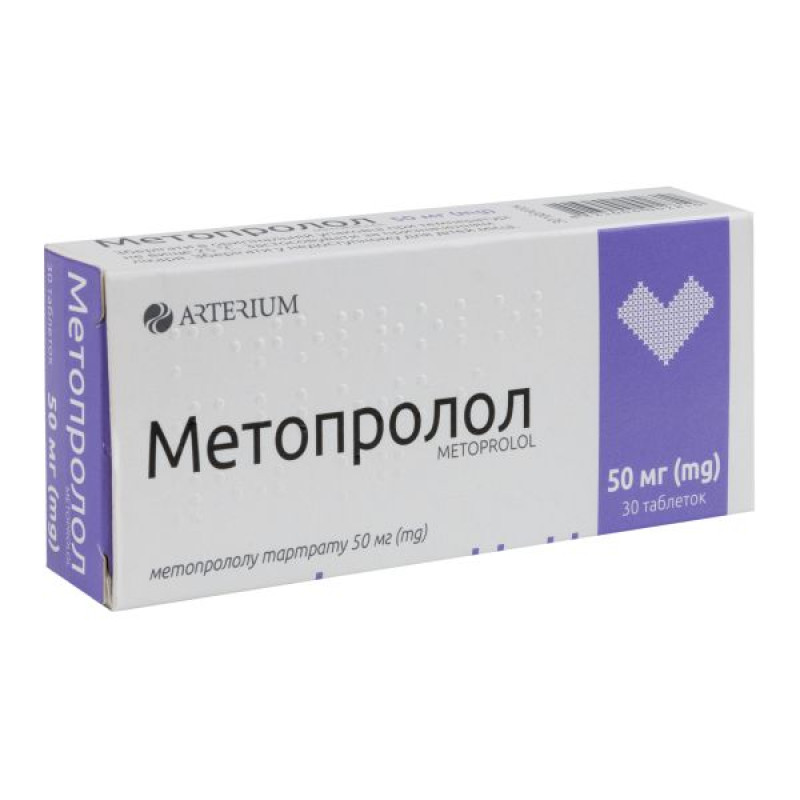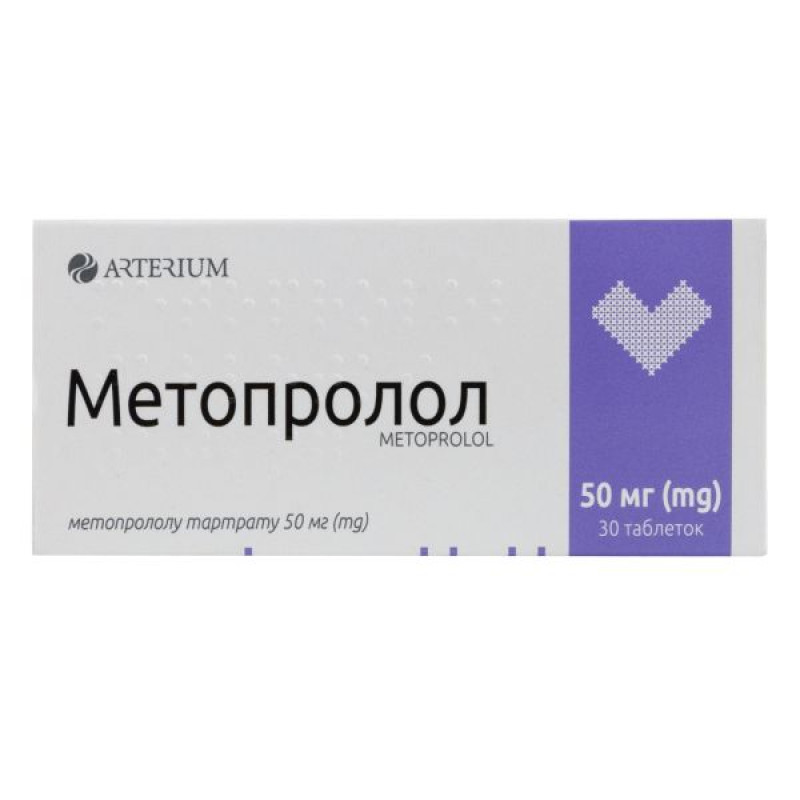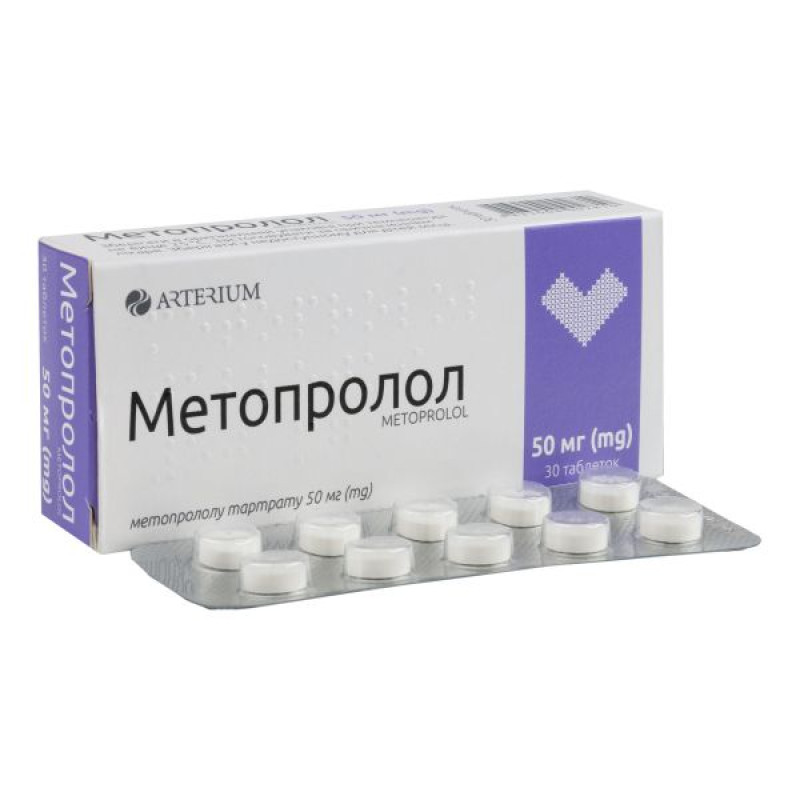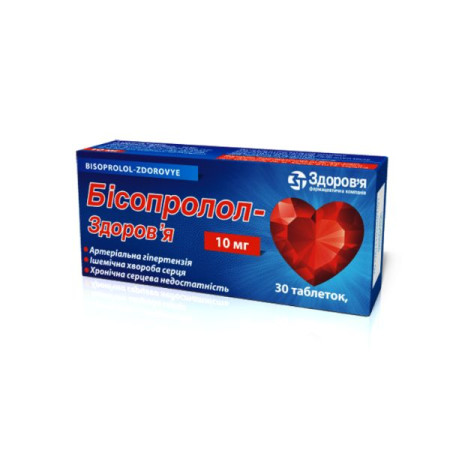Metoprolol tablets 50 mg No. 30

Instructions for use Metoprolol tablets 50 mg No. 30
Composition
active ingredient: metoprolol;
1 tablet contains metoprolol tartrate, calculated as 100% substance – 25 mg or 50 mg, or 100 mg;
Excipients: lactose monohydrate; microcrystalline cellulose; crospovidone; povidone; talc; calcium stearate.
Dosage form
Pills.
Main physicochemical properties: round tablets with a flat surface, white or white with a creamy tint, with two perpendicular intersecting lines and a bevel.
Pharmacotherapeutic group
Selective b-adrenergic receptor blockers.
ATX code C07A B02.
Pharmacological properties
Pharmacodynamics
Metoprolol is a b1-selective adrenergic receptor blocker without intrinsic sympathomimetic activity. It specifically blocks the action of catecholamines at the level of b1-adrenergic receptors. It reduces myocardial oxygen demand during exercise, which has a positive effect on long-term treatment of angina (reducing the frequency of pain attacks). It reduces systolic blood pressure, especially after exertion, and prevents the development of reflex orthostatic hypotension. A decrease in diastolic blood pressure occurs after several weeks of regular use. Metoprolol reduces plasma renin activity.
Pharmacokinetics
Absorption and distribution. After oral administration, metoprolol is completely absorbed. The concentration of metoprolol in the blood plasma is linearly dependent on the dose taken within the therapeutic dose range. The maximum plasma concentration (Cmax) is reached approximately 1.5-2 hours after administration (Tmax). Although the plasma concentration varies between individuals, the individual reproducibility is good. As a result of the important first pass effect during passage through the liver, the systemic bioavailability of metoprolol after a single oral dose reaches approximately 50%. After repeated administration, it increases to 70%. Administration with food can increase the bioavailability by 30-40%. The binding of metoprolol to plasma proteins is lower (approximately 5-10%).
Metabolism and elimination: Metoprolol is metabolized in the liver to form three metabolites that do not have clinically significant β-blocking effects.
Usually more than 95% of an oral dose of the drug is excreted in the urine. Approximately 5% of this dose is excreted in the urine unchanged; in some cases, the amount of the drug excreted in the urine unchanged may reach 30%. The average half-life is 3.5 hours (1-9 hours). The total rate of elimination from the blood plasma (clearance) is approximately 1000 ml/min.
In elderly patients, no significant changes in the pharmacokinetics of metoprolol are observed compared to those in young patients.
The systemic bioavailability and elimination of metoprolol are not altered in patients with renal insufficiency. However, the elimination of metabolites is reduced in such patients. In patients with a glomerular filtration rate of less than 5 ml/min, there is a significant accumulation of metabolites. This accumulation of metabolites has no β-blocking effect.
In patients with reduced liver function, the pharmacokinetics of metoprolol (due to low protein binding) are slightly altered. However, in patients with cirrhosis of the liver, the bioavailability of metoprolol may increase and the total clearance may decrease.
Indication
- Arterial hypertension.
- Angina pectoris (including post-infarction).
- Arrhythmia (including supraventricular tachycardia).
- Prevention of cardiac death and recurrent infarction after the acute phase of myocardial infarction.
- As part of complex therapy for thyrotoxicosis.
- Prevention of migraine attacks.
Contraindication
- Hypersensitivity to any component of the drug or to other β-blockers;
- atrioventricular block (II and III degrees), sinoatrial block;
- sick sinus syndrome;
- decompensated heart failure (pulmonary edema, hypoperfusion syndrome or arterial hypotension);
- pronounced bradycardia (heart rate ≤ 50 per 1 min);
- cardiogenic shock;
- severe peripheral circulatory disorders with pain or trophic changes;
- arterial hypotension (systolic blood pressure < 100 mm Hg);
- bronchial asthma, a severe form of chronic obstructive bronchopulmonary diseases;
- metabolic acidosis;
- untreated pheochromocytoma;
- prolonged or intermittent inotropic therapy with β-receptor agonists;
- concomitant therapy with monoamine oxidase-A inhibitors;
- the use of metoprolol is contraindicated in patients receiving intravenous calcium antagonists such as verapamil and diltiazem or other antiarrhythmic drugs (such as disopyramide).
Metoprolol should not be prescribed to patients with suspected acute myocardial infarction with a heart rate less than 50 beats/min, a P–Q interval >0.24 s, or a systolic blood pressure <100 mm Hg.
For patients with decompensated heart failure who tolerate other medications well, the use of metoprolol is possible with individual dose selection.
Interaction with other medicinal products and other types of interactions
Patients should be closely monitored if they are taking ganglioblockers, other β-blockers (e.g. eye drops) or monoamine oxidase inhibitors (MAOIs) concomitantly with Metoprolol.
Concomitant administration with propafenone should be avoided. Propafenone inhibits the metabolism of metoprolol via cytochrome P450 2D6. The result of such a combination is unpredictable, since propafenone also has β-blocking properties.
Abrupt withdrawal of clonidine from β-blocker therapy may result in an increase in blood pressure. If concomitant clonidine therapy is to be discontinued, the β-blocker should be discontinued several days prior to clonidine discontinuation.
In patients who are taking calcium antagonists of the verapamil type or diltiazem and/or drugs for the treatment of arrhythmias simultaneously with Metoprolol, negative inotropic and chronotropic effects are possible. Patients taking β-blockers should not be given intravenous verapamil (due to the risk of cardiac arrest). β-blockers may enhance the negative inotropic and chronotropic effects of drugs for the treatment of arrhythmias (quinidine analogues or amiodarone). Interaction with amiodarone (pronounced sinus bradycardia) may occur for a long time after discontinuation of this drug.
In patients treated with β-blockers, inhalation anesthetics enhance the cardiodepressive effect. Inducers or inhibitors of metabolism may affect the plasma concentration of metoprolol. The plasma concentration of metoprolol is reduced by rifampicin or may be increased by cimetidine, phenytoin, alcohol, hydralazine and serotonin reuptake inhibitors (paroxetine, fluoxetine and sertraline).
With concomitant treatment with indomethacin or other drugs that inhibit prostaglandin synthetase, the antihypertensive effect of β-blockers may be reduced.
Cardioselective β-blockers have a much smaller effect on blood pressure when patients are given adrenaline than nonselective β-blockers.
Diltiazem and β-blockers have additive inhibitory effects on AV conduction and sinus node function, and marked bradycardia may occur.
Beta-blockers may provoke paradoxical hypertensive reactions in patients taking high doses of phenylpropanolamine.
When β-blockers are taken concomitantly with insulin or oral antidiabetic agents, their effect may be enhanced or prolonged. In this case, the symptoms of hypoglycemia (especially tachycardia and tremor) may be masked or disappear. In such cases, regular monitoring of blood glucose levels is necessary.
Concomitant administration with barbiturates should be avoided, as barbiturates (studied with pentobarbital) stimulate the metabolism of metoprolol by enzyme induction. The plasma concentration of metoprolol may be affected by drugs that inhibit CYP 2D6, such as quinidine, terbinafine, paroxetine, fluoxetine, sertraline, celecoxib, propafenone and diphenhydramine. At the beginning of treatment with these drugs, a reduction in the dose of metoprolol may be necessary.
Concomitant use of digitalis glycosides and β-blockers may increase AV conduction time and cause bradycardia. Diphenhydramine reduces (by 2.5-fold) the clearance of metoprolol to α-hydroxymetoprolol via the CYP 2D6 system in subjects with rapid hydroxylation. The effects of metoprolol are enhanced. It is possible that diphenhydramine may inhibit the metabolism of other CYP 2D6 substrates.
Rifampicin may stimulate the metabolism of metoprolol, leading to a decrease in its plasma levels.
Caution should be exercised when combined with nitrates due to the risk of arterial hypotension and/or bradycardia.
Application features
When taking metoprolol tartrate, as with other β-blockers, it is necessary to monitor heart rate (HR) and blood pressure (BP) (initially daily, then once a month).
Patients taking β-blockers should not be given intravenous verapamil-type calcium antagonists.
In patients receiving β-blockers, adrenaline may increase blood pressure and cause (reflex) bradycardia; this reaction is less likely with selective β-blockers.
Metoprolol may exacerbate existing bradycardia.
Since metoprolol must be discontinued before surgery, discontinuation should be carried out no later than 48 hours before surgery, except in special cases, such as thyrotoxicosis or pheochromocytoma.
However, in some cases, preoperative administration of β-blockers may be beneficial because they can reduce the arrhythmogenic effects and reduce coronary blood flow during surgical stress, which favors sympathetic tone. If a patient is to receive a β-blocker for these reasons, an anesthetic with a weak negative isotropic effect should be chosen to reduce the risk of myocardial depression.
Before general anesthesia, the anesthesiologist should be informed that the patient is taking Metoprolol. It is not recommended to stop treatment during surgery.
Very rarely, pre-existing moderate atrioventricular conduction disturbances may worsen, sometimes with the development of atrioventricular block.
As a rule, when treating patients with asthma, concomitant therapy should be prescribed:
β2-agonists (tablets or aerosols). In cases where these patients start taking the drug, an increase in the dose of β2-agonists may be necessary. The risk of the drug affecting β2 receptors is lower than in the case of using conventional non-selective β1-blockers in tablets.
Particularly careful medical supervision is necessary in the treatment of patients with diabetes mellitus (blood glucose control), patients with unstable blood sugar levels, when using a strict fasting diet. During treatment with metoprolol, there is a minimal risk of affecting sugar metabolism or masked hypoglycemia compared to treatment with non-selective b-blockers.
Metoprolol may mask some clinical manifestations of thyrotoxicosis (e.g. tachycardia). Abrupt withdrawal of the drug in patients with thyrotoxicosis is contraindicated due to possible exacerbation of symptoms.
Patients undergoing treatment for heart failure should be treated before starting metoprolol and during this treatment.
Very rarely, pre-existing mild forms of AV conduction disorders may worsen and lead to more severe AV block. Patients with first degree AV block should be treated with this drug with great caution.
Metoprolol should be used with caution in patients with myasthenia gravis.
In case of development of bradycardia (heart rate less than 50-55 beats/min) during treatment with metoprolol, the dose should be reduced and/or the drug should be gradually discontinued.
Due to its hypotensive effect, the drug may increase the symptoms of peripheral circulatory disorders, such as intermittent claudication.
If the drug is used in patients with pheochromocytoma, an α-sympatholytic drug should be used in parallel.
If treatment must be discontinued and whenever possible, it should be discontinued over a period of 10-14 days with a daily dose reduction of 25 mg/day for the last 6 days. During this period, special attention should be paid to patients with coronary heart disease. The risk of heart attacks, including sudden death, may be increased when β-blocker treatment is discontinued.
Metoprolol may cause a slight increase in triglycerides and a decrease in free fatty acids in the blood. In some cases, a slight decrease in low-density lipoprotein (LDL) levels has been observed, and this was significantly less than with non-selective β2-blockers. However, there is evidence that one study showed a significant decrease in total cholesterol after treatment with metoprolol for several years.
There is insufficient experience with the use of metoprolol in patients with heart failure and the following concomitant factors: unstable heart failure (NYHA IV); acute myocardial infarction or unstable angina within the previous 28 days; impaired renal and hepatic function; patient age from 80 years and less than 40 years; hemodynamically significant valvular disease; hypertrophic obstructive cardiomyopathy; during or within 4 months after cardiac surgery. Treatment of such patients should be carried out by physicians with special skills and experience.
In patients with Prinzmetal's angina, the frequency and severity of angina attacks may increase due to α-receptor-mediated coronary vasoconstriction. Therefore, nonselective β-blockers should not be prescribed to such patients, and selective β1-blockers should be used with caution.
Anaphylactic shock is severe in patients treated with b-blockers.
Patients with a history of severe allergic reactions should be treated with metoprolol with great caution. Particular attention should also be paid to patients with allergic reactions who are treated with vaccines (desensitization therapy). The effect of the administration of usual doses of adrenaline may be absent.
Patients who wear contact lenses should be aware that the drug may reduce tear secretion.
Patients with psoriasis or a history of depressive disorders should be treated with metoprolol only after careful consideration of the benefit-risk ratio.
Special attention should be paid to patients with severe renal impairment, with serious acute conditions accompanied by metabolic acidosis and patients receiving combination treatment with digitalis preparations.
The drug contains lactose, so it should not be prescribed to patients with hereditary lactase deficiency, galactose intolerance or glucose/galactose metabolism disorders.
Use during pregnancy or breastfeeding
As a rule, β-blockers suppress placental blood flow, which can cause fetal growth retardation. Metoprolol can cause bradycardia, hypotension, hypoglycemia and respiratory depression in newborns, so its use should be discontinued 48-72 hours before the expected onset of labor. If this is not possible, the infant should be carefully monitored for 48-72 hours after birth.
On the other hand, the amount of metoprolol that the infant receives in breast milk to achieve a potential β-blockade effect is insignificant if the mother's metoprolol dose is within the normal therapeutic range. Breastfed infants should be carefully monitored for potential β-blockade effects.
Ability to influence reaction speed when driving vehicles or other mechanisms
Dizziness and fatigue may occur during treatment with the drug. Patients whose activities require mental alertness, such as driving a car or operating machinery, should be warned about the possibility of such effects.
Method of administration and doses
Metoprolol is intended for daily administration, preferably in the morning. The tablet should be taken without chewing, with sufficient amount of drinking water. During the period of dose selection, the heart rate should be monitored to prevent bradycardia. The maximum daily dose is 400 mg.
Arterial hypertension. The recommended dose is 100 mg (once in the morning or divided into two doses - morning and evening). If the therapeutic effect is not achieved with this dosage, the daily dose can be increased to 200 mg (once in the morning or divided into two doses - morning and evening) or the drug should be combined with other antihypertensive drugs.
Angina pectoris. The recommended dose of the drug is 50-100 mg 2-3 times a day. If necessary, the drug can be combined with other drugs for the treatment of angina pectoris.
Arrhythmia. The recommended dose is 50 mg 2-3 times a day. If necessary, the daily dose can be increased to 300 mg, divided into 2-3 doses.
In myocardial infarction (it is advisable to start treatment within the first 12 hours after the onset of chest pain). The recommended dose is 50 mg every 6 hours for 48 hours, the recommended maintenance daily dose is 200 mg, divided into two doses. The course of treatment is at least 3 months.
Hyperthyroidism (thyrotoxicosis). The recommended dose is 50 mg 4 times a day. When the therapeutic effect is achieved, the dose should be gradually reduced.
Prevention of migraine attacks. The recommended daily dose is 100-200 mg per day, divided into 2 doses.
Patients with renal impairment: No dose adjustment is necessary.
Patients with impaired liver function: Dose adjustment (reduction of the metoprolol dose) is usually necessary for patients with limited liver function (e.g., patients with cirrhosis).
Elderly patients: No dose adjustment is necessary.
Children. The use of the drug is contraindicated in children.
Overdose
Symptoms: metoprolol overdose can lead to a severe decrease in blood pressure, sinus bradycardia, atrioventricular block I-III degree, prolongation of the QT interval, asystole, insufficient peripheral perfusion, heart failure, cardiogenic shock, cardiac arrest, bronchospasm, respiratory depression or arrest, increased fatigue, impaired or loss of consciousness, fine tremor, convulsions, increased sweating, paresthesia, coma, nausea, vomiting, esophageal spasms, hypoglycemia (especially in children), hyperglycemia, cyanosis, hypokalemia, hyperkalemia, confusion, negative effects on the kidneys and transient myasthenic syndrome.
Concomitant use of alcohol, antihypertensive drugs, quinidine or barbiturates may worsen the patient's condition. The first signs of overdose may occur 20 minutes to 2 hours after overdose.
Glucagon should also be administered at a dose of 50-150 mcg/kg body weight intravenously, as well as amrinone. In case of significant bradycardia refractory to drug therapy, an artificial pacemaker should be used. To relieve bronchospasm, a β2-agonist should be administered intravenously. It should be borne in mind that the doses of antidotes required to eliminate the symptoms of an overdose of β-blockers are much higher than the therapeutic ones, since β-receptors are bound by β-blockers.
Toxicity. In an adult, a dose of 7.5 g caused fatal intoxication. Ingestion of 100 mg of the drug by a 5-year-old child was not accompanied by symptoms of intoxication after gastric lavage. Moderate intoxication was caused by a dose of 450 mg in a 12-year-old child and a dose of 2.5 g, and 7.5 g - very serious intoxication.
Close monitoring of the patient is necessary (circulatory and respiratory parameters, renal function, glucose level, serum electrolytes).
In case of myocardial depression: infusion of dobutamine or dobutamine and calcium gluconate 9 mg/ml, 10-20 ml.
Adverse reactions
From the blood and lymphatic system: thrombocytopenia, agranulocytosis, leukopenia.
Metabolic and nutritional disorders: weight gain.
On the part of the psyche: sleep disorders, drowsiness, insomnia, nightmares, depression, concentration disorder, memory disorders, amnesia, confusion, hallucinations, nervousness, anxiety.
From the nervous system: dizziness, headache, paresthesia, taste disturbance.
On the part of the organs of vision: visual impairment, dry eyes or conjunctivitis.
From the organs of hearing and balance: sensation of noise/ringing in the ears, hearing impairment.
Cardiac: postural disorders (very rarely with dizziness), cold extremities, bradycardia, atrioventricular block I, II or III degree, pericardial pain, chest pain, transient worsening of heart failure symptoms, tachycardia, arrhythmias, cardiac conduction disorders, arterial hypotension, cardiogenic shock in patients with acute myocardial infarction, palpitations.
Vascular: orthostatic hypotension (which in very rare cases is accompanied by syncope), Raynaud's syndrome, gangrene in patients with existing severe peripheral circulatory disorders.
Respiratory, thoracic and mediastinal disorders: dyspnea on exertion, bronchospasm, rhinitis.
Gastrointestinal: nausea, vomiting, abdominal pain, diarrhea, constipation, dry mouth, heartburn, bloating.
From the hepatobiliary system: hepatitis.
Skin and subcutaneous tissue disorders: hypersensitivity reactions, including rash (in the form of psoriatic and dystrophic skin lesions), urticaria, itching, erythema; photosensitivity, psoriasis, increased severity of psoriasis, increased sweating, hair loss; impaired fat metabolism.
Musculoskeletal and connective tissue disorders: muscle spasms, arthralgia, increased symptoms of intermittent claudication, muscle weakness.
Reproductive system and breast disorders: impotence/sexual dysfunction, Peyronie's disease.
General disorders and administration site conditions: fatigue, peripheral edema.
Laboratory parameters: abnormal liver function tests, appearance of antinuclear antibodies (not associated with systemic lupus erythematosus), decreased high-density lipoprotein (HDL) cholesterol, and increased triglycerides with normal total cholesterol.
Metoprolol can mask the symptoms of thyrotoxicosis and manifestations of latent diabetes mellitus.
Expiration date
5 years.
Storage conditions
Store in original packaging at a temperature not exceeding 25 ° C. Keep out of the reach of children.
Packaging
10 tablets in a blister. 3 blisters in a pack.
Vacation category
According to the recipe.
Producer
PJSC "Kyivmedpreparat".
Location of the manufacturer and its business address
Ukraine, 01032, Kyiv, Saksaganskoho St., 139.
There are no reviews for this product.
There are no reviews for this product, be the first to leave your review.
No questions about this product, be the first and ask your question.






